Solar panels are usually set up to be in full direct sunshine at the middle of the day facing South in the Northern Hemisphere, or North in the Southern Hemisphere. Therefore morning and evening sunlight hits the panels at an acute angle reducing the total amount of electricity which can be generated each day.

During the day the sun appears to move across the sky from left to right and up and down above the horizon from sunrise to noon to sunset. This is shown in the schematic above of the Sun's apparent motion as s
een from the Northern Hemisphere.
Solar Trackers
A solar tracker is a device onto which solar panels are fitted which tracks the motion of the sun across the sky ensuring that the maximum amount of sunlight strikes the panels throughout the day. When compared to the price of the PV solar panels themselves, the cost of a solar tracker is relatively low.
In terms of cost per Watt of the completed solar system, it is usually cheaper (for all but the smallest solar installations) to use a solar tracker and less solar panels where space and planning laws permit.
A good solar tracker can typically lead to an increase in electricity generation capacity of 30-50%.
How to Solar Trackers Work
There are many different types of solar tracker which can be grouped into single axis and double axis models.Single axis solar trackers can either have a horizontal or a vertical axle. The horizontal type is used in tropical regions where the sun gets very high at noon, but the days are short. The vertical type is used in high latitudes (such as here in the UK) where the sun does not get very high, but summer days can be very long.
Double axis solar trackers have both a horizontal and a vertical axle and so can track the Sun's apparent motion exactly anywhere in the World. This type of system is used to control astronomical telescopes, and so there is plenty of software available to automatically predict and track the motion of the sun across the sky.
Tracking the Sun
Above is a simplified schematic diagram of a vertical-axis solar tracker fitted to a solar panel located in the UK (high latitude Northern Hemisphere). A pair of sensors (typically a type of cadmium sulphide photoresistors are used) point to the East and West of the location of the Sun.
The light detected by the Eastward-facing sensor is at a lower intensity to that detected by the Westward-facing sensor. Therefore, the solar panel must be turned westwards (by the motor controlled by the solar tracker circuit) until the levels of light detected by both the East and the West sensors are equal. At that point the solar panel will be directly facing the sun and generated electricity optimally.
Obviously real world solar trackers (such as the one pictured above) are not so simple. A solar tracker must be able to reset itself at sunset so it is ready for sunrise, it must cope with heavy cloud, and it must work reliably 365 days a year. In addition a mount for the solar panel must be constructed which can cope with strong winds, and a suitable motor found.
Buy a Solar Tracker
A wide range of commercial solar trackers are available - typically in Australia, USA, and Germany. There are also great plans available free of charge online for building your own DIY solar tracker from easy to find components. Read on for some useful online commercial and DIY solar tracker resources.http://www.reuk.co.uk/Solar-Tracker.htm